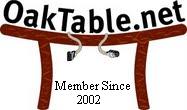The problem with blogging is there is no way to clearly write something tongue-in-cheek. No facial expressions, no smirking, no hand waving—just plain old black and white. That aside, I can’t resist posting a follow-up to a post on StorageMojo about ZFS performance. I’m not taking a swipe at StorageMojo because it is one of my favorite blogs. However, every now and again third party perspective is a healthy thing. The topic at hand is this post about ZFS performance which is a digest of this post on digitalbadger.net. The original post starts with:
I have seen many benchmarks indicating that for general usage, ZFS should be at least as fast if not faster than UFS (directio not withstanding)[…]
Right off the bat I was scratching my head. I have experience with direct I/O dating back to 1991 and have some direct I/O related posts here. I was trying to figure out what the phrase “directio not withstanding” was supposed to mean. The only performance boost direct I/O can possibly yield is due to the elimination of the write-ordering locks generally imposed by POSIX and the double-buffering/memcopys overhead associated with the DMA into the page cache—and subsequent copy into the user address space buffer. So for a read-intensive benchmark, about the only thing one should expect is less processor overhead, not increased throughput.
Anyway, the post continues:
To give a little background : I have been experiencing really bad throughput on our 3510-based SAN. The hosts are X4100s, 12Gb RAM, 2x dual core 2.6Ghz opterons and Solaris 10 11/06. They are each connected to a 3510FC dual-controller array via a dual-port HBA and 2 Brocade SW200e switches, using MxPIO. All fabric is at 2Gb/s […]
OK, the 4100 is a 2-way Opteron 2000 server which, being a lot like an HP Proliant DL385, should have no problem consuming all the data the 2 x 2Gb FCP paths can deliver—roughly 400MB/s. If the post is about a UFS versus ZFS apples-apples comparison, both results should top out at the maximum theoretical throughput of 2x2Gb FCP. The post continues:
On average, I was seeing some pretty average to poor rates on the non-ZFS volumes depending on how they were configured, on average I was seeing 65MB/s write performance and around 450MB/s read on the SAN using a single drive LUN.
I’d be plenty happy with that 450MB/s given that configuration. The post insinuates this is direct I/O so getting 450MB/s out of 2x2Gb FCP should be the end of the contest. Further, getting 65MB/s written to a single drive LUN is quite snappy! What is left to benchmark? It seems UFS cranks the SAN at full bandwidth.
The post continues:
I then tried ZFS, and immediately started seeing a crazy rate of around 1GB/s read AND write, peaking at close to 2GB/s. Given that this was round 2 to 4 times the capacity of the fabric, it was clear something was going awry.
Hmmm…Opterons with HT 2.0 attaining peaks of 2GB/s write throughput via 2x2Gb FCP? There is nothing awry about this, it is simply not writing the data to the storage.
This is a memory test. ZFS is caching, UFS is not.
The post continues:
Many thanks to Greg Menke and Tim Bradshaw on comp.unix.solaris for their help in unravelling this mystery!
What mystery? I’d recommend testing something that runs longer than 1 second (reading 512MB from memory on any Opteron system should take about .6 seconds. I’d recommend a dataset that is about 2 fold larger than physical memory.
How Does ZFS and UFS Compare to Other Filesystems?
Let’s take a look at an equivalent test running on the HP Cluster Gateway internal filesystem (the former PolyServe PSFS). The following is a screen shot of a dd(1) test using real Oracle datafiles on a Proliant DL585. The first test executes a single thread of dd(1) reading the first 512MB of one of the files using 1M read requests. The throughput is 815MB/s. Next, I ran 2 concurrent dd(1) processes each chomping the first 512MB out of two different Oracle datafiles using 1MB read requests. In the concurrent case, the throughput was 1.46GB/s.
NOTE: You may have to right click->view the image.
But wait, in order to prove the vast superiority of the HP Cluster Gateway filesystem over ZFS using similar hardware, I fired off 6 concurrent dd(1) processes each reading the first 512MB out of six different files. Here I measured 2.9GB/s!




Kevin, wouldn’t you know that *another* set of tests came in, and to my untrained eye they look better than Digital Badgers.
Check it out at StorageMojo.
Robin
Yeah, his test what little bit strange.
One correction – using directio also disables read-aheads at least in UFS. This actually can help random read performance.
Robert,
You are correct that direct I/O disables read-ahead. Speaking as an Oracle guy here, there are workloads where the OS read-ahead *can* help, but in general tuning queries to use Oracle PQO will cause sufficiently aggressive scanning. I’m not 100% against anything. If buffered UFS works for one purpose or the other, go for it…no religion here.
Robin,
I commented on Robert’s blog asking for some clarification. Looks to me like it is a comparison of HW RAID 10+SW RAID 1 versus Software RAID 10. Also, the stripe width in the “HW RAID (really has software RAID in there too)” case is important, but not mentioned.